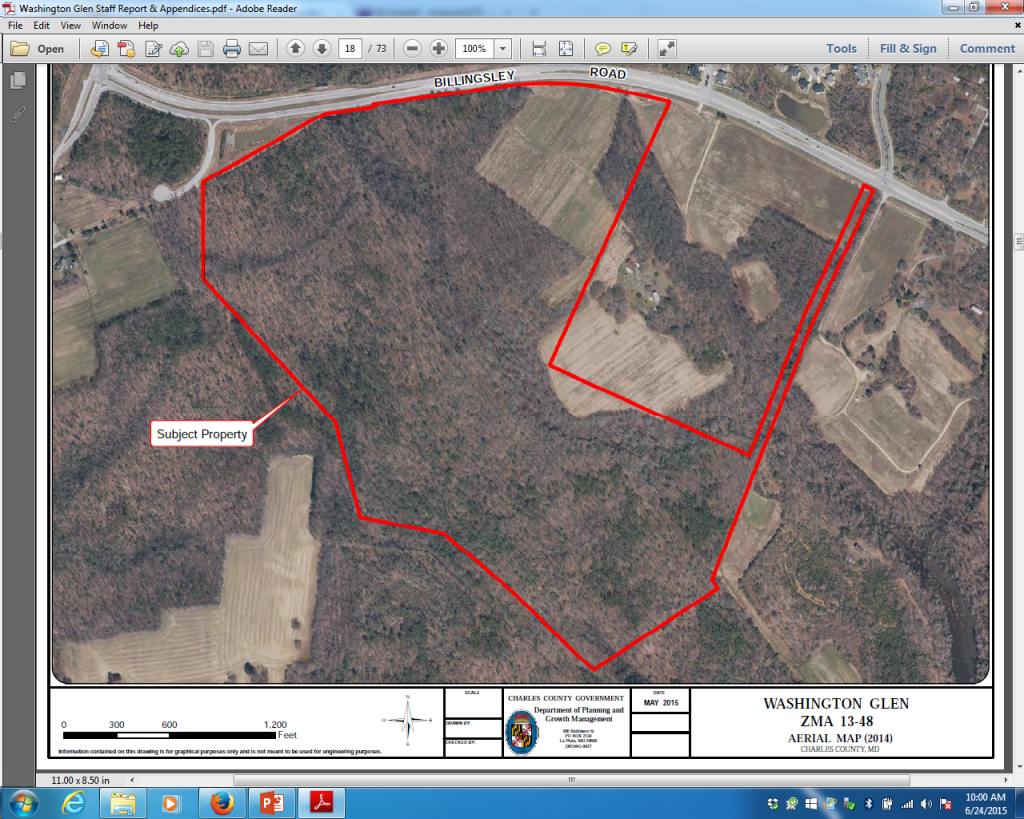
PTRC President Jerry Forbes testified before the Charles County Planning commission on Tuesday, June 22, opposing a zoning map amendment for the proposed Washington Glen project near the intersection of Billingsley and Middletown Roads. This project would convert 137 acres in the present-day “deferred development district” to medium residential zoning, an increase in density of 30 times. Nearly all of the tract is in the headwaters of the Port Tobacco River.
Here is his testimony.
Good evening. My name is Jerry Forbes and I am the President of the Board of Directors of the Port Tobacco River Conservancy. Since 2001, PTRC has worked with businesses, residents, local and state governments, and other conservation groups to restore and protect the Port Tobacco River and streams in the watershed. PTRC balances restoration and protection with economic development concerns and the value of its river and watershed to both the local and state economies.
I urge you to adopt the recommendation of the Department of Planning and Growth Management Staff Report and deny the requested rezoning for the Washington Glen project. This project would be located on 136 acres of land in the headwaters of the Port Tobacco River. We believe this property’s current zoning, Rural Conservation Deferred Development District, or RC(D), provides the needed protection for this environmentally sensitive area. This would not be the case if the property were rezoned to allow medium to high-density residential development.
The Importance of Headwater Streams
Stream health indicators such as macro-invertebrates decline noticeably whenever impervious surfaces (roofs, paved parking lots) within watersheds exceeds 10 percent. Impervious surfaces change the rate and route in which water enters the stream system, they prevent infiltration, change the flow regime within the stream system and prevent groundwater recharge, which impacts the dry weather base flow of the streams. Runoff from impervious surfaces also increases the amount of nitrogen, phosphorus, and suspended solids in the water. The effects of these changes are particularly critical when they occur in headwater streams, as they affect downstream water quality.
This property contains over 3,500 feet of unnamed tributaries of the Port Tobacco Creek, all of which is surrounded by forest. The property’s current uses of forest and agriculture are consistent with RC(D) zoning, which is intended to preserve the rural environment and natural features of the area, while maintaining low density residential development and existing agricultural activities. These uses are far better suited to protecting the health of these headwater streams than the proposed use of medium to high density residential development will be.
Goals of the WRAS
The County and the public have already agreed on the ecological, aesthetic, scenic, recreational, and economic value of a healthy Port Tobacco watershed. In 2007, the County adopted for implementation the Watershed Restoration Action Strategy (WRAS) for the Port Tobacco River. One of the stated goals of the WRAS is to mitigate future changes to watershed hydrology, and the WRAS recommends preserving 50% of the Port Tobacco watershed.
The Chesapeake Bay TMDL
The County also must consider its obligations under the Chesapeake Bay TMDL, which establishes annual total nitrogen, total phosphorus, and total suspended solids (sediment) allocations for the watershed areas draining into the Chesapeake Bay.
A specific example of concern is the wetlands near the Route 6 bridge and Rose Hill road. For the past 40–50 years, the Port Tobacco Creek has eroded and deepened because of the increased volume of storm water from developments with impervious surfaces and discharges from waste water treatment plants. This has left the former wetland south of the bridge dry, driving out the waterfowl, other birds, and wildlife that once lived there and no longer filtering out nutrients and sediment. The county in partnership with a landowner has a project to restore the highly eroded stream banks and bottom to allow the natural overflow of the stream to go into the former wetlands south of the bridge. The County’s investment in this project could be put in jeopardy if there are significant changes in upstream headwaters hydrology due to runoff from added impervious surfaces.
Conclusion
For all these reasons, we ask you to adopt the recommendation of the planning staff and deny this requested rezoning to protect the health of the Port Tobacco River and its watershed for generations to come. Thank you for listening!